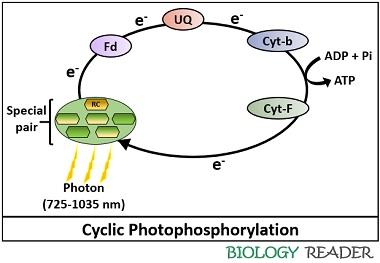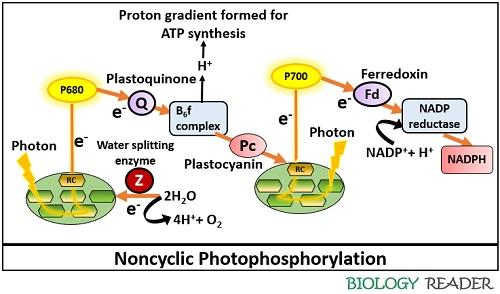The difference between cyclic and noncyclic photophosphorylation is mainly due to the following factors:
Type of photosynthesis: Cyclic photophosphorylation occurs during anoxygenic photosynthesis, while noncyclic photophosphorylation occurs in oxygenic photosynthesis.
ATP synthesis: ATP synthesis during the cyclic electron flow of anoxygenic photosynthesis is known as cyclic photophosphorylation. ATP production during the noncyclic electron flow of oxygenic photosynthesis is known as noncyclic photophosphorylation.
Movement of electrons: During cyclic and non-cyclic photophosphorylation, the electrons move in a cyclic and straight path, respectively.
Photophosphorylation or photosynthetic phosphorylation is a process that generates ATP by adding a phosphate group into ADP during the light photosynthetic reaction.
Content: Cyclic Vs Noncyclic Photophosphorylation
Comparison Chart
| Properties | Cyclic photophosphorylation | Noncyclic photophosphorylation |
|---|---|---|
| Meaning | Cyclic photophosphorylation refers to the process which produces ATP during the cyclic electron transport chain of light dependent photosynthesis | Noncyclic photophosphorylation refers to the process which produces ATP from noncyclic electron transport chain in light reactions of photosynthesis |
| Occurrence | Predominantly occurs in photosynthetic bacteria | Primarily occurs in higher plants, algae and cyanobacteria |
| Photosynthesis type | It follows anoxygenic photosynthesis | It follows oxygenic photosynthesis |
| Flow pattern of electron | The electrons flow in a cyclic or circular pattern | The electrons flow linearly in a zig-zag pattern |
| Photosystem involved | It involves photosystem-I only | It involves photosystem-I and photosystem-II |
| First electron donor | The first electron donor is PS I | Water is the first electron donor |
| Reaction centre | Reaction centre PS-I first excites the electron | Reaction centre PS-II first excites the electron |
| Final electron acceptor | The final electron acceptor is PS I | The final electron acceptor is NADP+ |
| Photolysis of water | Water do not split during this process | Water splits or photolyses |
| Oxygen production | Oxygen is not generated during cyclic photophosphorylation | Molecular oxygen is generated in noncyclic photophosphorylation |
| Energy produced | Only ATP is produced in this process | ATP and NADPH are produced in this process |
| Oxygen involvement | Occurs during anaerobic conditions | Occurs during aerobic conditions |
| Carbon dioxide involvement | Occurs when the CO2 concentration is less in the atmosphere | Occurs at normal CO2 concentration |
| Effect of Diuron | The process is not inhibited by diuron | The process is sensitive to the diuron |
Definition of Cyclic Photophosphorylation
It refers to the light reaction of the photosynthetic process, which prevalently occurs in the prokaryotes or photosynthetic bacteria. Cyclic photophosphorylation only involves photosystem I (P700). It is termed cyclic because electrons return to the photosystem I after releasing the chemical energy, i.e. ATP.
Thus, the electrons move to and fro within the photosystem by following a cyclic path. The organisms undergoing cyclic photosynthesis restore electron supply, due to which reduction of NADP does not occur. It does not require water hydrolysis to replenish electron loss.
Definition of Noncyclic Photophosphorylation
It refers to the light reaction of the photosynthetic process, which predominately occurs in green plants and algae. Noncyclic photophosphorylation involves both the photosystems, i.e. PS-I (P700) and PS-II (P680). It is termed noncyclic due to the zig-zag flow of electrons.
The organisms undergoing noncyclic photosynthesis synthesize ATP via PS-II. Concurrently, PS-I releases electrons that the PS-I captures to reduce NADP into NADPH. It requires water hydrolysis to replenish electron loss by the PS-II. Oxygen is produced as a byproduct through the oxidation of water.
Cyclic Photophosphorylation Steps
It involves photosystem-I that absorbs a photon of wavelength (725-1035 nm). Green sulfur and nonsulfur bacteria, purple bacteria, acidobacteria etc., carry out cyclic photophosphorylation. Bacteria undergo cyclic photosynthesis via four bacteriochlorophylls.

Two bacteriochlorophylls participate in the photon absorption, and the other two remains inactive. Thus, the reaction centre excites electrons to the next state via photon absorption by the special pair of bacteriochlorophyll. As the high energy electrons leave the reaction centre, it makes the bacteriochlorophyll positively charged.
Then, the excited electrons pass through many cofactors and protein complexes in the ETS and finally return to the final electron acceptor, i.e. photosystem-I. As photosystem II is not used during cyclic photophosphorylation, no oxygen is produced.
Noncyclic Photophosphorylation Steps
It requires both PS-I and PS-II. Generally, noncyclic photophosphorylation predominantly occurs in all green plants, algae, and cyanobacteria. PS-II (P680) captures photons from the light source and later transfers them to the RC chlorophyll.
The RC chlorophyll excites electrons from a ground state to a higher energy level. Then, the primary electron acceptor receives the e–. Afterwards, excited electrons travel through the cytochrome b6f complex to PS-I (P700) via ETS.
During this transfer of electrons, photosynthetic cells utilize energy to transport proton molecules (H+) across the thylakoid membrane into the thylakoid lumen. Then, plastoquinone accepts protons.
The movement of proton ions across the membrane creates a potential difference between the thylakoid lumen and the chloroplast stroma. The potential difference generates a proton-motive force, which a cell uses to drive free energy, i.e. ATP via an enzyme complex (ATP synthase).

Photosynthetic cells use ATP to transport H+ ions from the lumen to the stroma. Then, the electrons reach PS-I through plastocyanin to fulfil the electron deficiency of the RC chlorophyll. Electrons pass through the cofactor ferredoxin to the enzyme complex NADP+ reductase. The electrons and H+ ions pass the NADP+ complex to form NADPH.
Then, the NADPH (reducing agent) and ATP are transported to the Calvin cycle to fix carbon dioxide into triose sugars. Both react with glycerate 3-phosphate to form a triose sugar glyceraldehyde 3-phosphate. G 3-P is the basic building block from which plants can make a variety of substances. Noncyclic photosynthetic liberates molecular oxygen along with the energy molecules (ATP and NADPH).
Key Differences Between Cyclic and Noncyclic Photophosphorylation
- Cyclic and noncyclic photophosphorylation pathways are light-dependent photosynthetic reactions that generate ATP following the cyclic and noncyclic electron transport chain.
- Cyclic photophosphorylation follows anoxygenic photosynthesis that predominantly occurs in photosynthetic bacteria like green sulfur and nonsulfur bacteria, purple bacteria etc. Oppositely, noncyclic photophosphorylation follows oxygenic photosynthesis that predominantly occurs in autotrophic green plants, algae and cyanobacteria.
- Electrons flow in a cyclic or circular pattern during cyclic phosphorylation as electrons return to the PS-I. Conversely, electrons flow linearly in a zig-zag pattern in noncyclic phosphorylation by going out of the PS-II, entering into the PS-I, and finally to the NADP+.
- In cyclic phosphorylation, water does not lyse to give protons and oxygen. Oppositely, water molecule photolyses to liberate oxygen into the atmosphere during noncyclic phosphorylation.
- Diuron functions as an inhibitory agent commonly used as herbicide and algaecide, inhibiting the noncyclic photophosphorylation.
Similarities
- Both cyclic and noncyclic photophosphorylation is the light-dependent photosynthetic reaction.
- Cyclic and noncyclic photophosphorylation processes are the part of ETS that carry out phosphorylation (addition of phosphate group) or ATP formation.
Conclusion
Therefore, we can conclude that cyclic and noncyclic photophosphorylation is the light-dependent photosynthetic pathways that carry out phosphorylation to produce ATP. The ATP is then used by the photosynthetic cells to perform various activities for their growth and survival.